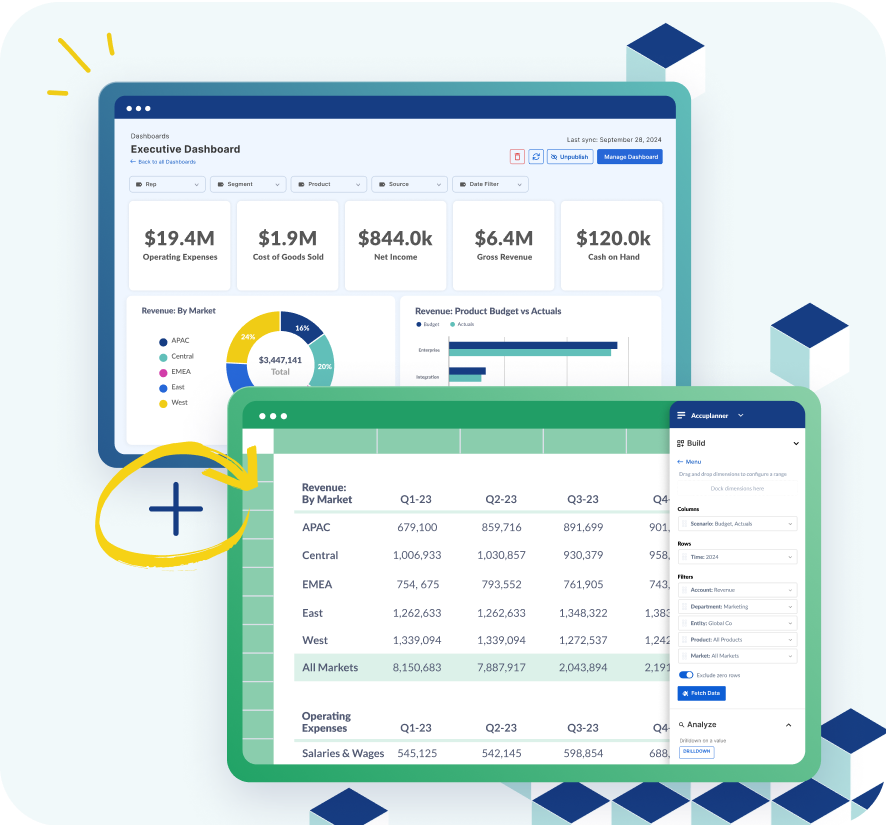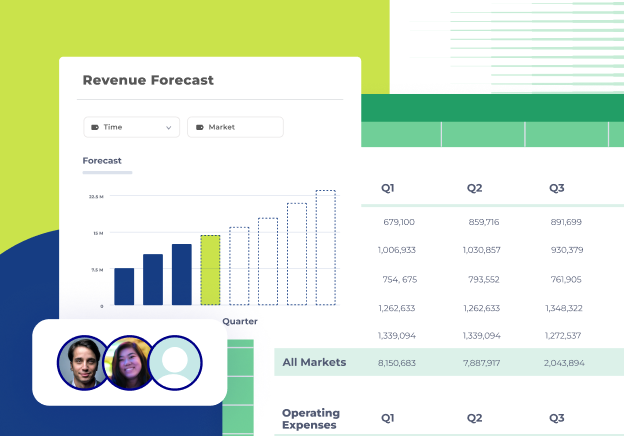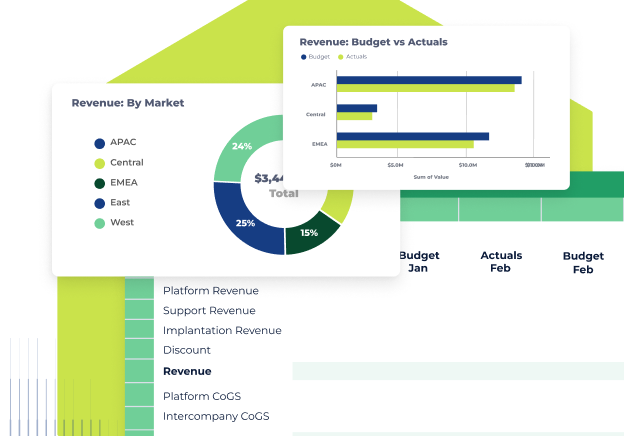Best financial modeling tools at a glance
Before we dive into the details, here’s a sneak peek at some of the best financial modeling tools available today:
- Cube
- Oracle BI
- Jirav
- Finmark
- Quantrix
- Synario
- IBM Cognos
- Sage Intacct
- Jedox
- Anaplan
- Mosaic Tech
What is financial modeling software?
Financial modeling software uses artificial intelligence (AI) to build accurate financial forecasts. It does this by gathering data from systems like accounting software, CRM tools, and spreadsheets, and then organizing and analyzing it. This processed data helps the software generate different business scenario models and project potential outcomes, such as sales growth or cost reductions.
Plus, it improves prediction accuracy by eliminating manual tasks prone to human error. Businesses depend on the software to evaluate past results, understand current financial health, and plan strategically for the future.
Why is financial modeling important?
Financial modeling is about the past, present, and future. Aggregated and analyzed historical data provides businesses with a picture of their current financial health and an accurate estimate of their financial future. The best financial models are developed with financial modeling tools.
Financial analysts use financial modeling tools to determine a company's value or a project's viability. The software provides an outlook for specific business conditions to maximize profitability and opportunity.
Financial modeling with spreadsheets vs. financial modeling software
Financial modeling spreadsheets are usually created in Excel or Google Sheets from scratch by an FP&A professional.
When relying solely on spreadsheets, FP&A teams must manually aggregate, input, and analyze the data for financial modeling. This is time-consuming and can lead to errors and miscalculations.
Financial modeling software enhances the way FP&A teams work with spreadsheets, transforming manual processes into more efficient workflows. Instead of relying solely on spreadsheets for data input, aggregation, and analysis, FP&A software like Cube integrates seamlessly with tools like Excel and Google Sheets.
This allows teams to continue using the spreadsheets they know and trust while automating data updates, ensuring accuracy, and providing advanced features like scenario modeling and real-time collaboration. Rather than replacing spreadsheets, FP&A software empowers teams to work smarter and more efficiently, combining the flexibility of spreadsheets with the scalability of modern technology.
Key features of financial modeling tools
Financial modeling tools offer several key features that enhance their functionality and utility. These often include:
AI-powered modeling
Traditionally, finance teams relied on basic financial modeling formulas—often limited by the tools and data available—to estimate the potential impact of business decisions. These models were built on static assumptions and required significant manual effort to update and adapt as new information became available.
With AI-powered FP&A software, finance teams can now build dynamic, data-driven models that adapt in real-time to changing conditions. AI tools can analyze vast datasets, uncover hidden patterns, and generate predictive insights that go far beyond what traditional formulas could achieve.
Custom, multi-scenario modeling
Users can create customized models tailored to specific business needs, providing a higher level of flexibility and precision.
Many financial modeling tools support multi-scenario analysis, allowing businesses to evaluate multiple outcomes based on different assumptions and variables, making it easier to plan for different future possibilities.
These tools can also accommodate a wide range of scenarios, helping companies prepare for the best-case, worst-case, and most likely scenarios, enhancing strategic planning and risk management.
Trusted data access and validation
Ensuring data accuracy is crucial in financial modeling, as erroneous data can lead to flawed analyses and poor decision-making. Manually checking data can be a time-consuming process that pulls valuable resources away from more strategic tasks.
Advanced financial modeling tools provide robust mechanisms for validating data inputs to ensure consistency across all data points used in the models. Maintaining data integrity throughout the modeling process allows users to trust the results and make informed decisions based on reliable information.
Automated audit trails
Financial modeling tools include features for creating automated audit trails, which are essential for maintaining a transparent and accountable financial modeling process.
This capability tracks all changes made to financial models, documenting who made the changes and when they were made, thus providing a clear history of modifications.
Automated audit trails enhance transparency, facilitate compliance with auditing standards and regulatory requirements, and make it easier to identify and rectify any errors or inconsistencies.
Source system integrations
Integrating with source systems such as accounting software, CRM platforms, and ERP systems is a key capability of most financial modeling tools, ensuring that data flows seamlessly into the financial models.
This integration allows for the real-time import of accurate data, keeping financial models up-to-date and reflective of the latest business conditions.
These tools pull data directly from trusted source systems, reducing manual data entry, minimizing errors, and enhancing the overall efficiency and reliability of the financial modeling process.
Multi-currency support
Businesses often operate in multiple currencies, requiring financial models that can handle various monetary units.
Financial modeling tools with multi-currency support enable users to perform financial analysis and report in different currencies. These tools allow businesses to convert and consolidate financial data across currencies seamlessly, ensuring that financial reports and analyses are consistent and compliant with global standards.
Collaboration features
Most financial modeling tools make it easy for finance teams to share insights with stakeholders and decision-makers. Data sharing, change tracking, and customizable access permissions help multiple users collaborate on models in real time.
Teams can quickly distribute reports, gather meaningful feedback, and ensure everyone makes decisions based on the most up-to-date financial data.
Data visualization and reporting
Financial modeling tools typically include automated financial reporting that can transform raw numbers into easy-to-understand visuals like charts, graphs, and dashboards. This allows finance teams and stakeholders to grasp key insights, trends, and patterns at a glance instead of trying to decode rows of data.
You can even customize the looks of reports to highlight your most important metrics, compare key scenarios, and present summaries in digestible ways.
Best financial modeling software
Accurate and accessible financial models are invaluable to every organization. Here’s an overview of the best financial modeling software options on the market right now.
1. Cube

Cube is a first-of-its-kind FP&A software platform that allows you to use AI to automate, actualize, and control data with the click of a button. Integrated spreadsheets currently in your business model can be transformed into usable data so finance teams can skip the busy work and focus on analysis and growth.
Teams can use Cube’s advanced AI to automate manual workflows, reduce errors, and improve collaboration to make faster, smarter business decisions. Most companies complete onboarding within two weeks, ensuring quick time-to-value at a competitive price.

Key features:
- Automated data consolidation: Connect data from numerous sources for automated rollups and drill-downs.
- Multi-scenario analysis: Seamlessly model how changes to key assumptions affect overall outputs.
- Smart forecasting: Access AI-generated forecasts help teams identify trends, predict outcomes, and uncover risks before they impact performance.
- Conversational insights: Ask Cube’s AI Analyst questions directly in Slack, Microsoft Teams, or your Cube Workspace—and get instant, explainable answers.
- Customizable dashboards: Build and share comprehensive dashboards tailored to your specific needs.
- Native Excel and Google Sheets integration: Compatible and bi-directional with any spreadsheet.
- Multi-currency support: Evaluate your financials in both your local and reporting currencies.
- User-based controls: Ensure that the correct data goes to the right people at the right time with user controls, validations, and an audit trail.
- Centralized formulas and KPIs: Store all your calculations in a central location and manage data from a single source of truth.
- Drill-down and audit trail: Access the transactions and history behind a single data cell with just one click.
Pros:
- Empowers department leaders to create their own scenarios and forecasts
- Provides a single source of truth for all data
- Offers seamless integrations with spreadsheets (Google Sheets and Excel), accounting and finance, HR, ATS, billing and operations, sales and marketing, and business intelligence tools
- Saves time by automating menial tasks
Cons:
Pricing:
Starting at $30,000 annually, Cube offers custom plans with:
- Universal spreadsheet experience
- Unlimited users
- Unlimited saved templates
- Unlimited dimensions

2. Oracle BI

Oracle BI pairs with other Oracle products to deliver visual analytics and calculations for sales, HR, supply chain, and more. The platform combines machine learning and artificial intelligence to data to support decision-making and predictions.

Image source
Key features:
- Provides secure data warehousing to users.
- Offers remote storage and server ability.
- Includes an at-a-glance dashboard.
- Allows ad-hoc reporting with predictive and profit analysis.
Pros:
- Facilitates visual report building with a single dataset and delivery to multiple sources.
- Utilizes existing PL/SQL code.
- Allows the saving of reports for recurring use.
Cons:
- Poses a steep learning curve, especially for businesses not currently uising Oracle products.
- Presents visually unappealing reports, especially compared to other BI products.
- Lacks adequate tech support.
Pricing:
The Oracle BI price list guide shares a detailed review of prices. To summarize:
- Standalone BI application: Starts at $250/user.
- BI fusion edition applications: Starts at $5,800/user and ranges up to $40,000/user.
- Enterprise products: Starts at $600/user and range up to $24,500/user.
3. Jirav

Jirav works to offer faster and more collaborative financial planning. Users can employ driver-based budgeting models to merge company-wide data, create predictions and forecasts, and facilitate real-time feedback and collaboration.

Image source
Key features:
- Offers financial forecasting and cash flow projections.
- Provides workforce planning with data modeling.
- Includes executive summary reports with custom KPIs.
- Integrates payroll, accounting, and general ledger functionalities.
Pros:
- Offers pre-built formulas and templates.
- Facilitates roll forward forecasts and data without spreadsheets.
- Provides customizable dashboards for financial and non-financial data.
Cons:
- Features a steeper learning curve.
- Provides limited variety in visualizations.
- Works best for smaller businesses that can afford a higher price point.
Pricing:
- Industry Safari: $20,000+/team
- Strategy Safari: Custom pricing

4. Finmark

Finmark helps businesses plan for growth by building accurate financial models. Finmark is best for smaller businesses and startups seeking guidance in creating hiring plans, fundraising goals, and scenario planning.

Image source
Key features:
- Allows model customization with multiple scenarios.
- Facilitates team collaboration on financials.
- Provides visualization options for specific metrics.
- Supports planning for fundraising and budgeting.
Pros:
- Improves financial planning and forecasts.
- Allows searching across numerous data points.
- Features an intuitive and easy to use interface.
Cons:
- Offers limited integrations.
- Presents a higher learning curve and limited help center.
- Focuses primarily on SaaS companies.
Pricing: Finmark starts at $50/month and rises based on a company’s annual revenue. Once a company’s annual revenue exceeds $3M, pricing is by quote only.
5. Quantrix

Quantrix is an integrated modeling platform that enables users to make decision-making easier. The platform focuses on error-proofing financial data interactions for enterprise-level businesses.

Image source
Key features:
- Offers a timely alert system for potential errors or miscalculations.
- Provides a collaborative cloud modeling system.
- Facilitates the drafting of models from included templates.
- Integrates into other platforms for enhanced functionality.
Pros:
- Enables users to build forecasts and run what-if and multiple-scenario analyses.
Cons:
- Provides few visual depictions of data.
- Poses a steep learning curve for those unfamiliar with SQL.
Pricing: While pricing is not available on their website, sources report that the Quantrix Modeler desktop application costs $2,600/year. Quantrix Qloud pricing is by request only.
6. Synario
.png?width=166&height=35&name=synario-logo%20(1).png)
Synario is a financial modeling app with pre-mapped accounting and integrated financial statements. You can customize their financial models for initial analysis or to create presentations for stakeholders. Synario is cloud-based, so no installation is required.

Image source
Key features:
- Manages multiple accounts with version control.
- Provides financial oversight with profitability analysis.
- Generates income and balance sheets with a general ledger.
- Offers asset lifecycle management capabilities.
Pros:
- Provides adaptable and scalable financial models.
- Offers cloud-based access for quick availability.
Cons:
- Software updates may alter the functionality of certain features.
- Poses a steep learning curve.
- Changing a model once it’s built can be difficult.
Pricing: An online source shares that Synario is available for $5,000/year.
7. IBM Cognos

IBM Cognos is an IBM Watson-powered solution for cleaning, collecting, and analyzing data. It provides automated data prep and exploration, user-generated reports, and data visualizations of current and projected business operations.

Image source
Key features:
- Imports data from spreadsheets and CSV files.
- Connects to local or remote databases for reporting.
- Utilizes AI features for data preparation.
- Enables the creation of dynamic dashboards locally and remotely.
Pros:
- Accelerates data preparation with artificial intelligence.
- Collects both on-premise and cloud data.
- Utilizes interactive dashboards for visual presentations.
Cons:
- Focuses on adding new functionalities rather than improving the existing product.
- Reports may contain bugs and can be difficult to rectify.
- Restricts application integrations.
Pricing: Cloud subscriptions start at $10.60/user/month. For hosted or on-premise plans, you’ll have to contact them for a quote.
8. Sage Intacct

Sage Intacct is financial reporting software that enhances user efficiency and offers extensive reporting customization. The platform suits various industries, including SaaS (software-as-a-service) and hospitality.

Image source
Key features:
- Imports essential financial information for seamless integration.
- Creates business plans and forecasts.
- Generates historical and forward-looking financial reports by pairing live actuals with financial models.
- Transforms data into insights with drag-and-drop charts and tiles.
Pros:
- Offers fast setup with native integrations.
- Facilitates sharing of plans and budgets without spreadsheets.
- Allows tailored dashboards for different audiences to drive quick decision-making.
- Integrates with Cube.
Cons:
- May be too complex for small businesses.
- Requires effort to integrate and set up initially.
- Features a higher learning curve.
Pricing: Sage Intacct offers custom pricing upon request.
9. Jedox

Jedox's financial modeling software offers a comprehensive tool for organizations aiming to enhance their financial planning and analysis capabilities. It provides pre-configured best practice models that can be easily tailored to specific requirements, facilitating collaboration across departments, data sources, and teams.
By consolidating data and processes organization-wide, Jedox ensures a unified source of information for all financial modeling needs, even amidst rapid changes.

Image source
Key features:
- Uses predefined models to start modeling quickly and reduce preparation time.
- Integrates with multiple data sources and systems.
- Supports dynamic scenario modeling, identifies patterns, anomalies, and operational bottlenecks.
- Facilitates cross-departmental collaboration with live updates and close model integration.
- Converts base currency amounts into reporting currencies, beneficial for international operations.
Pros:
- Enables rapid setup with pre-configured models for immediate use.
- Easily customizable to align with unique business requirements.
- Enhances modeling accuracy and decision-making with AI-driven insights.
- Facilitates efficient collaboration across departments with up-to-date information.
Cons:
- Requires significant setup and customization to fully leverage capabilities.
- Integration with existing systems can be complex and may pose challenges.
- The software necessitates time for initial setup and training.
Pricing: While Jedox doesn’t disclose prices online, an online source shares that they start at $160/user/month.
10. Anaplan

Anaplan is an enterprise-grade planning platform that enables companies to connect, model, and optimize their business processes. It’s designed for finance teams and business users to build robust models for comprehensive financial, sales, HR, and supply chain plans.
The solution includes an application platform for creating or modifying financial planning and utilizes proprietary Hyperblock technology for building what-if scenarios.

Image source
Key features:
- Provides advanced modeling capabilities for intricate business models.
- Ensures data accuracy, integrity, and accessibility with data management tools.
- Supports real-time sharing and editing of planning models with collaboration capabilities.
- Allows users to gain actionable insights from their planning data with reporting and analytics features.
Pros:
- Users can create intricate business models tailored to specific needs.
- Supports real-time sharing and editing of planning models.
Cons:
- The implementation and usage costs can be prohibitive, ranging from $30,000–$50,000 or more.
- New users may find the system complex, requiring extensive training and time to master.
- To fully leverage Anaplan's capabilities, substantial customization and setup time may be necessary.
Pricing: Anaplan doesn’t disclose specific pricing online, but does share that it offers three plans: Basic, Professiona, and Enterprise. Contact them for a custom quote.
11. Mosaic Tech

Mosaic Tech is a financial modeling software that enables businesses to forecast future performance outcomes using real-time data, flexible drivers, prebuilt templates, and advanced assumptions.
It integrates accounting, workforce, customer, operational, and financial data to provide comprehensive insights for better decision-making. Mosaic’s tools allow users to build dynamic financial forecasts, run what-if scenarios, and make collaborative decisions faster and more precisely.

Image source
Key features:
- Connects accounting, workforce, customer, operational, and financial data.
- Models potential outcomes using custom inputs, real-time metrics, and growth strategies.
- Produces historical and forward-looking financial reports quickly.
- Shares progress and updates with teams for collaborative planning.
- Builds what-if scenarios to assess the impact of changes on profitability.
- Plans hiring impacts and accounts for fully-loaded headcount costs.
Pros:
- Offers fast setup with real-time data integration.
- Simplifies financial modeling and reporting with an intuitive design.
- Eliminates manual data entry by syncing operational and financial data automatically.
Cons:
- The complexity of the software can overwhelm users.
- Installation and setup are time-consuming and require adjustments.
- Has fewer features compared to other similar software.
Pricing: Mosaic Tech offers custom pricing across three plans: Analytics, Foundation, and Growth.
Get started with the best financial modeling software
Better, more accurate financial models are invaluable to every organization. Whether you're a startup navigating uncertain waters or a well-established enterprise planning for growth, the ability to forecast, analyze, and strategize with precision can make all the difference.
Fortunately, modern financial modeling software empowers teams to automate tedious tasks, integrate data seamlessly, and visualize complex scenarios with little effort.
If your team is looking for an easier, faster way to create multi-scenario forecasts, conduct sensitivity analyses, or present board-ready reports, Cube may be the solution you’re looking for.
Cube transforms raw data into actionable intelligence, unlocking new opportunities, mitigating risks, and driving sustainable growth. Want to see for yourself how Cube can help your business? Request a free demo today.



.png)









.png)

![Best financial modeling software [2026 review]](https://www.cubesoftware.com/hubfs/Financial%20Modeling%20Software%20(1).png)








